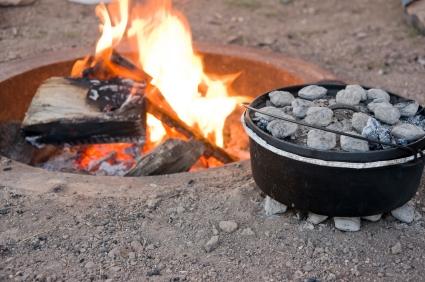Summer is a great time to experiment with alternative cooking methods, so we’re highlighting Dutch ovens in a week-long series of posts.
Dutch ovens produce some of the tastiest meals by using a constant heat maintained over a longer duration. This series will take you from getting your first Dutch oven to creating a magnum opus. Enjoy!

Dutch Oven Basics—Picking Your Oven
“How many of us would know how to cook for our families if electricity and natural gas were suddenly gone? With the Dutch oven skills I’ve learned over the years, I have confidence that I can cook my family a good hot meal at any time, regardless of our ‘current’ circumstances!” ~ Byron Bills, Expert Dutch oven chef
Dutch oven cooking may intimidate you, but the basics are fairly easy to master even if you are a beginner. Here are some tips for picking a Dutch oven.
Indoor or Outdoor: What’s the Difference?
The first rule for picking a Dutch oven is deciding whether you want to use your oven for indoor or outdoor cooking. Indoor ovens have flat bottoms and are meant to sit on the rack in conventional ovens. Outdoor ovens have three legs that sit over hot coals, and a lid with a lip. This lip is meant to keep the coals from sliding off.
You can use indoor Dutch ovens outdoors, but you’ll need to make a few adjustments. For this series we’ll be focusing on outdoor ovens.
Types of Ovens: Cast Iron and Cast Aluminum
Dutch ovens are made from either cast iron or cast aluminum; each type has its own benefits and drawbacks.
Aluminum ovens can be washed with soapy water. Aluminum is also better used for foods that need to cool quickly once they’re cooked, but cooking temperatures can vary based on wind or atmospheric temperature changes.
Cast iron is preferred by many Dutch oven professionals because it keeps a more even cooking temperature and keeps food warm longer. Also, cast iron ovens like
the Volcano are very durable and can last for generations.
Follow your manufacturer’s recommendations for washing, drying, and seasoning a new Dutch oven before using it. In general, cast iron ovens should NOT be washed with soapy water (unless you have just taken it out of the package for the first time). Putting soap in a cast iron oven will destroy the ‘seasoning’ and will seep into the pores, where it can leach out into your next meal.
Seasoning refers to the vegetable oil or butters that you coat the Dutch oven with before each use. Seasoning stays within the walls of a Dutch oven during each use, building up over time. It prevents rust and corrosion and creates a non-stick cooking surface. Don’t get rid of the seasoning!
Oven Sizes
Dutch ovens come in sizes from 8 to 22 inches in diameter. The depths vary too, giving you a wide range of choices.
The smallest ovens are good for vegetables, sauces, side dishes and desserts; the largest will accommodate a good-sized turkey with vegetables. Don’t forget that the bigger your Dutch oven, the more it will weigh. Byron has a 49 quart Dutch oven that weighs 158 pounds—empty!
Because of the weight and size of Dutch ovens, you want to choose an oven with three sturdy legs; skinny legs might break.
If you’re only purchasing one oven, the 12-inch size, that holds about 6 quarts, is probably the most useful. A 10-inch and a 14-inch would also be very handy to have, especially if you’re cooking several foods at the same time.
Keep in mind that when you’re cooking you can stack several ovens (smallest on top) and conserve coals by placing them between ovens, as they will heat both upward and downward.
Oven Accessories (You’re Going to Need These!!)
- You will want a shovel, a selection of tongs and hooks, and good insulated leather gloves to help you handle your hot, heavy ovens. A whisk broom is handy to brush ashes off lids before you open the oven.
- Charcoal chimney starter
- Consider keeping your charcoal in a large bucket or garbage can topped with a tight-fitting lid.
Now that you’ve learned how to pick a Dutch oven, you can learn how to cook with it!
Check out the next installment of our Dutch Oven Mini Series, “
Dutch Oven Basics—Prepping and Cooking with your Oven.”
Check out the rest of our Dutch oven series:
Dutch oven Basics Part Two: Prepping and Cooking with Your Oven
Dutch oven Basics Part Three: Breakfast Recipes
Dutch oven Basics Part Four: Sides and Main Dishes
Dutch oven Basics Part Five: Desserts



3 comments
Dutch Oven
great article! Keep it up!
Jay
Great series. Thank you.
beprepared
You’re welcome! —Sarah